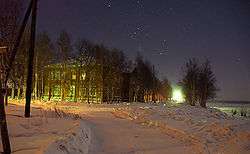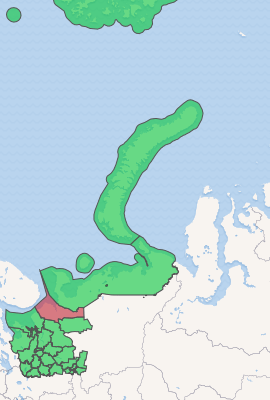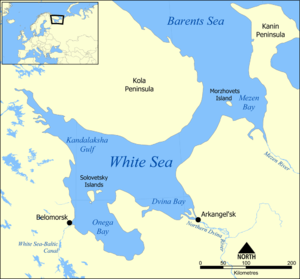Mezensky District
Mezensky District (Russian: Мезе́нский райо́н) is an administrative district (raion), one of the twenty-one in Arkhangelsk Oblast, Russia.[1] As a municipal division, it is incorporated as Mezensky Municipal District.[8] It is located in the northeast of the oblast and borders with Nenets Autonomous Okrug in the northeast, Ust-Tsilemsky District of the Komi Republic in the east, Leshukonsky and Pinezhsky Districts in the south, and with Primorsky District in the southwest. From the north, the district borders the White Sea. The area of the district is 34,400 square kilometers (13,300 sq mi).[4] Its administrative center is the town of Mezen.[3] Population: 10,330 (2010 Census);[5] 13,124 (2002 Census);[10] 17,796 (1989 Census).[11] The population of Mezen accounts for 34.6% of the total district's population.[5]
Mezensky District Мезенский район | |
|---|---|
 School in Mezen | |
.png) Flag  Coat of arms | |

Location of Mezensky District in Arkhangelsk Oblast | |
| Coordinates: 64°51′N 44°14′E | |
| Country | Russia |
| Federal subject | Arkhangelsk Oblast[1] |
| Established | July 15, 1929[2] |
| Administrative center | Mezen[3] |
| Area | |
| • Total | 34,400 km2 (13,300 sq mi) |
| Population | |
| • Total | 10,330 |
| • Estimate (2018)[6] | 8,809 (-14.7%) |
| • Density | 0.30/km2 (0.78/sq mi) |
| • Urban | 59.6% |
| • Rural | 40.4% |
| Administrative structure | |
| • Administrative divisions | 1 Towns of district significance, 1 Urban-type settlements with jurisdictional territory, 13 Selsoviets |
| • Inhabited localities[3] | 1 Cities/towns, 1 Urban-type settlements[7], 52 Rural localities |
| Municipal structure | |
| • Municipally incorporated as | Mezensky Municipal District[8] |
| • Municipal divisions[8] | 2 Urban settlements, 12 Rural settlements |
| Time zone | UTC+3 (MSK |
| OKTMO ID | 11642000 |
| Website | http://www.mezen.ru/ |
History
The area was originally populated by the Finno-Ugric peoples and then colonized by the Novgorod Republic. After the fall of Novgorod, the area became a part of the Grand Duchy of Moscow. Komi started moving to the Mezen in the 14th and 15th centuries. First Russian settlements on the Mezen were mentioned in the 16th century. The lower course of the Mezen, the current area of the district, was where Russian culture existed in its original state, not mixing with the Komi culture.[12] The town of Mezen was founded in the 16th century as Okladnikova Sloboda. The area was at the time located on one of the main ways from central Russia to the Pechora River basin and to the Ural Mountains.[13]
In the course of the administrative reform carried out in 1708 by Peter the Great, the area was included into Archangelgorod Governorate. In 1780, the governorate was abolished and transformed into Vologda Viceroyalty, and Mezen got the town rights. In 1796, the area was transferred to Arkhangelsk Governorate. The current territory of the district was included into Mezensky Uyezd. On December 28, 1917, a new Ust-Vashsky Uyezd with the administrative center in Ust-Vashka (currently Leshukonskoye) was established; however, in 1925 it was merged back into Mezensky Uyezd.[14] In 1929, several governorates were merged into Northern Krai. On July 15, 1929, the uyezds were abolished and Mezensky District was established. It became a part of Arkhangelsk Okrug of Northern Krai.
In the following years, the first-level administrative division of Russia kept changing. In 1930, the okrug was abolished, and the district was subordinated to the central administration of Northern Krai. In 1936, the krai itself was transformed into Northern Oblast. In 1937, Northern Oblast was split into Arkhangelsk Oblast and Vologda Oblast. Mezensky District remained in Arkhangelsk Oblast ever since.[2]
Geography
The district is elongated from west to east. A major part of the district belongs to the basins of the Mezen River (with the main tributaries the Pyoza and the Kimzha) and the Kuloy River (with the Nemnyuga and the Soyana), which both end up in the Mezen Bay of the White Sea. Areas on the White Sea coast drain directly into the sea, and some areas in the northeast of the district drain into the Pyosha River and other rivers of the Barents Sea basin.
Almost the whole of the district is covered by coniferous forests (taiga). The northern part of the district is transitional area between taiga and tundra (lesotundra). There are many glacial lakes across the district. The biggest lakes are east of the Mezen, Lake Varsh (shared with Nenets Autonomous Okrug), Lake Pocha, and Lake Vyzhletskoye.
The district also includes Morzhovets Island which separates the Mezen Bay from the entrance of the White Sea. The island is the only part of the district which lies above the Arctic Circle.

The part of the district located east of the Mezen is essentially unpopulated, with the exceptions of the right bank of the river and of several villages in the valley of the Pyoza.
Divisions
As an administrative division, the district is divided into thirteen selsoviets, one town of district significance (Mezen), and one urban-type settlement with jurisdictional territory (Kamenka).[3] The following selsoviets have been established (the administrative centers are given in parentheses):[3]
- Bychensky (Bychye)
- Dolgoshchelsky (Dolgoshchelye)
- Dorogorsky (Dorogorskoye)
- Koydensky (Koyda)
- Kozmogorodsky (Kozmogorodskoye)
- Lampozhensky (Lampozhnya)
- Moseyevsky (Moseyevo)
- Ruchyovsky (Ruchyi)
- Sovpolsky (Chizhgora)
- Soyansky (Soyana)
- Tselegorsky (Tselegora)
- Yolkinsky (Safonovo)
- Zherdsky (Zherd)
Municipal divisions
As a municipal division, the district is divided into two urban settlements and twelve rural settlements (the administrative centers are given in parentheses):[8]
- Mezenskoye Urban Settlement (Mezen)
- Kamenskoye Urban Settlement (Kamenka)
- Bychenskoye Rural Settlement (Bychye)
- Dolgoshchelskoye Rural Settlement (Dolgoshchelye)
- Dorogorskoye Rural Settlement (Dorogorskoye)
- Koydenskoye Rural Settlement (Koyda)
- Kozmogorodskoye Rural Settlement (Kozmogorodskoye)
- Moseyevskoye Rural Settlement (Moseyevo)
- Ruchyovskoye Rural Settlement (Ruchyi)
- Safonovskoye Rural Settlement (Safonovo)
- Sovpolskoye Rural Settlement (Chizhgora)
- Soyanskoye Rural Settlement (Soyana)
- Tselegorskoye Rural Settlement (Tselegora)
- Zherdskoye Rural Settlement (Zherd)
Restricted access
The northern part of the district is included into border security zone, intended to protect the borders of Russia from unwanted activity. In particular, the town of Mezen, the urban-type settlement of Kamenka, and the whole White Sea coast within the district, including such rural localities as Ruchyi, Koyda, and Dolgoshchelye, as well as Morzhovets Island, are included into this restricted area. In order to visit the zone, a permit issued by the local FSB department is required.[15]
Economy
Agriculture
Historically, fishery was the main source of income in the White Sea coast. The selo of Dolgoshchelye in the estuary of the Kuloy River was the main harbor of fishermen. In Soviet times, the fishery in the Arctic Ocean was state-sponsored; after 1990 the funds were cut, and the fishery went into decline.[16]
A special breed of horses, Mezen horse, was bred in the Mezen River valley. The Mezen horses are rather small but suitable for difficult work and easily survive cold winters.[17]
Transportation
Both the Mezen and the Kuloy Rivers are navigable within the district limits; however, there is no passenger navigation except for the ferry boats across the rivers. Until 2008, there were no all-seasonal roads in the district. During winter, temporary roads (zimniks) are built in snow; in summer, air transport is the only means for passenger connections to Arkhangelsk and the rest of the world. Currently, there is one all-seasonal road which connects the village of Kimzha with Arkhangelsk via Pinega, and two branches from this road along the right bank of the Mezen. One branch runs north to the town of Mezen, whereas the second one runs south to the selo of Leshukonskoye.
There is an airport in Mezen, with several weekly flights to Arkhangelsk. There is also an airport in Kamenka.[18]
The majority of the villages of the district are not connected by all-season roads to the main road network, and the only means of getting to Mezen and Arkhangelsk is by air.
Culture and recreation
The district contains two objects classified as cultural and historical heritage by Russian Federal law, and additionally a number of objects classified as cultural and historical heritage of local importance.[19] The objects under federal protection are the wooden bell tower in the selo of Dolgoshchelye (burned down in 1994 and no longer exists)[16] and the wooden Hodegetria Church in the village of Kimzha (1709, currently disassembled). The objects under local protection are wooden churches, chapels, windmills, peasant and merchant houses.
The only state museum in the district is the Mezen Regional Museum, located in the town of Mezen.[20]
References
Notes
- Law #65-5-OZ
- "Административно-территориальное деление Архангельской губернии в XVIII-XX вв. (Справка)" (in Russian). Архивы России. 2000. Archived from the original on July 24, 2011. Retrieved July 27, 2011.
- Государственный комитет Российской Федерации по статистике. Комитет Российской Федерации по стандартизации, метрологии и сертификации. №ОК 019-95 1 января 1997 г. «Общероссийский классификатор объектов административно-территориального деления. Код 11 242», в ред. изменения №278/2015 от 1 января 2016 г.. (State Statistics Committee of the Russian Federation. Committee of the Russian Federation on Standardization, Metrology, and Certification. #OK 019-95 January 1, 1997 Russian Classification of Objects of Administrative Division (OKATO). Code 11 242, as amended by the Amendment #278/2015 of January 1, 2016. ).
- Мезенский район (in Russian). Двина-Информ. Retrieved August 3, 2011.
- Russian Federal State Statistics Service (2011). "Всероссийская перепись населения 2010 года. Том 1" [2010 All-Russian Population Census, vol. 1]. Всероссийская перепись населения 2010 года [2010 All-Russia Population Census] (in Russian). Federal State Statistics Service.
- "26. Численность постоянного населения Российской Федерации по муниципальным образованиям на 1 января 2018 года". Federal State Statistics Service. Retrieved January 23, 2019.
- The count of urban-type settlements may include the work settlements, the resort settlements, the suburban (dacha) settlements, as well as urban-type settlements proper.
- Law #258-vneoch.-OZ
- "Об исчислении времени". Официальный интернет-портал правовой информации (in Russian). June 3, 2011. Retrieved January 19, 2019.
- Russian Federal State Statistics Service (May 21, 2004). "Численность населения России, субъектов Российской Федерации в составе федеральных округов, районов, городских поселений, сельских населённых пунктов – районных центров и сельских населённых пунктов с населением 3 тысячи и более человек" [Population of Russia, Its Federal Districts, Federal Subjects, Districts, Urban Localities, Rural Localities—Administrative Centers, and Rural Localities with Population of Over 3,000] (XLS). Всероссийская перепись населения 2002 года [All-Russia Population Census of 2002] (in Russian).
- "Всесоюзная перепись населения 1989 г. Численность наличного населения союзных и автономных республик, автономных областей и округов, краёв, областей, районов, городских поселений и сёл-райцентров" [All Union Population Census of 1989: Present Population of Union and Autonomous Republics, Autonomous Oblasts and Okrugs, Krais, Oblasts, Districts, Urban Settlements, and Villages Serving as District Administrative Centers]. Всесоюзная перепись населения 1989 года [All-Union Population Census of 1989] (in Russian). Институт демографии Национального исследовательского университета: Высшая школа экономики [Institute of Demography at the National Research University: Higher School of Economics]. 1989 – via Demoscope Weekly.
- Иванова, Т. Г. (2003). К истории региона. Былины Мезени: Север Европейской России. Былины (Свод русского фольклора). 25. Saint-Petersburg: Наука. pp. 7–11. Retrieved August 5, 2011.
- Энциклопедия Города России. Moscow: Большая Российская Энциклопедия. 2003. p. 256. ISBN 5-7107-7399-9.
- Лешуконский район (in Russian). Лешуконский муниципальный район. Retrieved August 1, 2011.
- "Приказ ФСБ РФ от 2 июня 2006 года N 237 "О пределах пограничной зоны на территории Архангельской области"". Rossiyskaya Gazeta (in Russian). 2006.
- Глезеров, Сергей (August 27, 2002). Сказка о потерянном рае, или как живётся в Долгощелье. Невское время (in Russian). Saint-Petersburg. Retrieved August 6, 2011.
- Мезенская лошадь. Great Soviet Encyclopedia.
- Аэропорт Каменка (in Russian). МойАрхангельск.Ру. Archived from the original on March 28, 2012. Retrieved August 5, 2011.
- Памятники истории и культуры народов Российской Федерации (in Russian). Russian Ministry of Culture. Retrieved June 2, 2016.
- Мезенский историко-краеведческий музей (in Russian). Российская сеть культурного наследия. Retrieved August 5, 2011.
Sources
- Архангельское областное Собрание депутатов. Областной закон №65-5-ОЗ от 23 сентября 2009 г. «Об административно-территориальном устройстве Архангельской области», в ред. Областного закона №232-13-ОЗ от 16 декабря 2014 г. «О внесении изменений в отдельные Областные Законы в сфере осуществления местного самоуправления и взаимодействия с некоммерческими организациями». Вступил в силу через десять дней со дня официального опубликования. Опубликован: "Волна", №43, 6 октября 2009 г. (Arkhangelsk Oblast Council of Deputies. Oblast Law #65-5-OZ of September 23, 2009 On the Administrative-Territorial Structure of Arkhangelsk Oblast, as amended by the Oblast Law #232-13-OZ of December 16, 2014 On Amending Various Oblast Laws Dealing with the Process of Municipal Self-Government and Relations with Non-Profit Organizations. Effective as of the day which is ten days after the official publication.).
- Архангельское областное Собрание депутатов. Областной закон №258-внеоч.-ОЗ от 23 сентября 2004 г. «О статусе и границах территорий муниципальных образований в Архангельской области», в ред. Областного закона №224-13-ОЗ от 16 декабря 2014 г. «Об упразднении отдельных населённых пунктов Соловецкого района Архангельской области и о внесении изменения в статью 46 Областного закона "О статусе и границах территорий муниципальных образований в Архангельской области"». Вступил в силу со дня официального опубликования. Опубликован: "Волна", №38, 8 октября 2004 г. (Arkhangelsk Oblast Council of Deputies. Oblast Law #258-vneoch.-OZ of September 23, 2004 On the Status and Borders of the Territories of the Municipal Formations in Arkhangelsk Oblast, as amended by the Oblast Law #224-13-OZ of December 16, 2014 On Abolishing Several Inhabited Localities in Solovetsky District of Arkhangelsk Oblast and on Amending Article 46 of the Oblast Law "On the Status and Borders of the Territories of the Municipal Formations in Arkhangelsk Oblast". Effective as of the day of the official publication.).
.png)